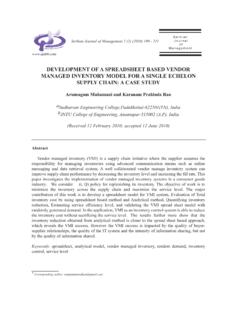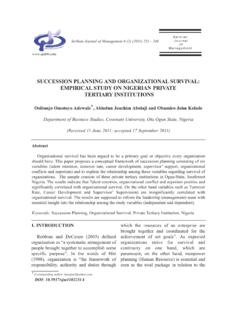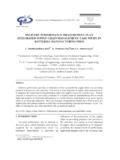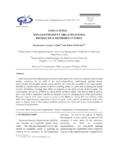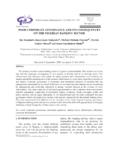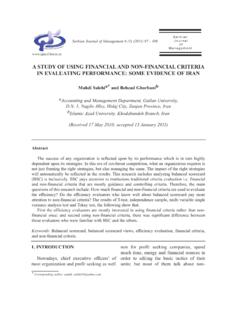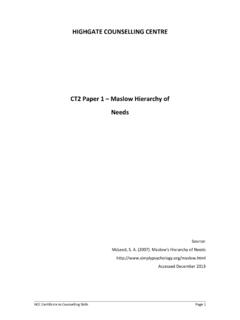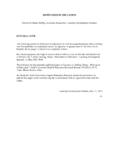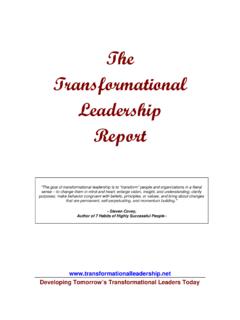Transcription of A STUDY ON MOTIVATIONAL FACTORS OF THE …
1 1. INTRODUCTION Motivation is one of the most importantfactors affecting human behaviour andperformance. There were times whenemployees were considered to be anotheraddition to enhance the production ofservices or goods. However, a lot haschanged now. Elton Mayo conducted aresearch during the year 1924 and 1932altered the way of thinking about research was known as HawthorneStudies. According to this STUDY , employeesrequire much more than just money. Thestudy introduced the human relationsapproach to a company s management(Nickson, 1973). The main focus was givento the basic requirements and motivationfactors of employees. The publication of theHawthorne STUDY facilitated theunderstanding of FACTORS that helped inmotivating employees. There are severalA STUDY ON MOTIVATIONAL FACTORS OF THE FACULTYMEMBERS AT UNIVERSITY OF BALOCHISTAN Nadeem Malik*University of Balochistan Quetta, Pakistan(Received 10 december 2009; accepted 12 February 2010)Abstract There were times when employees were considered to be another addition to enhance theproduction of services or goods.
2 However, a lot has changed now. Motivating employees is anecessary step that every business owner should take to succeed. This is because motivationencourages better performance and productivity on the part of employees. And when this happens,the company has nothing to enjoy but benefits and profit. Hence, it is natural for owners, managers,and team leaders to look for ways to improve the morale of their workers. This STUDY examined theranked importance of MOTIVATIONAL FACTORS of employees at the University of Balochistan. It is thedescriptive survey addressed eight motivating FACTORS in the context of employee motivation suggest that living in safe area and good pay are key to higher employee designed reward systems that include job enlargement, job enrichment, promotions,monetary, and non-monetary compensation should be considered.
3 Keywords: MOTIVATIONAL theories, ranked importance, comparison*Corresponding author: Journalof ManagementSerbian Journal of Management 5 (1) (2010) 143 - 149 that employees require to bemotivated first, an organization can easilysurvive when employees are have proved that motivatedemployees are more productive. Managersmust under the factor that motivatesemployees with respect to the roles theyperform. (Hedeian, 1993).2. SIGNIFICANCE In this changing world there is a need ofmotivated employees so that they cansurvive in the organization and it will alsogive help in the development of theorganization. (John,1994). Although the taskof motivation is very complex as it changesperson to person (Bowen & Radhakrishna,1991). Some research suggests that asemployees' income increases, moneybecomes less of a motivator (Maoch, 1988).
4 Also, as employees get older, interestingwork becomes more of a DEFINING MOTIVATION Motivation is to inspire people to work,individually or in groups in the ways such asto produce best results. It is the will to act. Itis the willingness to exert high levels ofeffort towards organizational goals,conditioned by the efforts and ability tosatisfy some individual need (Kreitner,1995).Motivation is getting somebody to dosomething because they want to do it. It wasonce assumed that motivation had to beinjected from outside, but it is nowunderstood that everyone is motivated byseveral differing forces. (Buford et al., 1995)Motivation is a general term applied to theentire class of drives, desires, needs, wishesand similar forces. To say that managersmotivate their subordinates is to say that theydo those things which they hope will satisfythese drives and desires and induce thesubordinates to act in a desired manner(Higgins, 1994).
5 To motivate others is the most importantof management tasks. It comprises theabilities to communicate, to set an example,to challenge, to encourage, to obtainfeedback, to involve, to delegate, to developand train, to inform, to brief and to provide ajust reward. (Bedeian, 1993) For this paper,motivation is defined as the inner force thatdrives individuals to accomplish personaland organizational MOTIVATION THEORIES In 1943 Abraham H. maslow , the basis ofMaslow's motivation theory is that humanbeings are motivated by unsatisfied needs,and that certain lower FACTORS need to besatisfied before higher needs can be to maslow , there are general typesof needs (physiological, survival, safety,love, and esteem) that must be satisfiedbefore a person can act unselfishly. He calledthese needs "deficiency needs." As long aswe are motivated to satisfy these cravings,we are moving towards growth, toward self-actualization.
6 Satisfying needs is healthy,while preventing gratification makes us sickor act evilly. According to various literatures onmotivation, individuals often have problemsconsistently articulating what they want froma job. Therefore, employers have ignoredwhat individual s say that they want, insteadtellingemployees what they want, based onwhat managers believe most people / SJM 5 (1) (2010) 143 - 149under the circumstances. Frequently, thesedecisions have been based on maslow 'sneeds hierarchy , including the factor ofprepotency. As a person advances through anorganization, his employer supplies orprovides opportunities to satisfy needshigher on maslow 's pyramid. Frederick (1959) has tried to modifyMaslow s need hierarchy theory. His theoryis also known as two-factor theory orHygiene theory. He stated that there arecertain satisfiers and dissatisfiers foremployees at work.
7 In- trinsic FACTORS arerelated to job satisfaction, while extrinsicfactors are associated with devised his theory on the question: Whatdo people want from their jobs? He askedpeople to describe in detail, such situationswhen they felt exceptionally good orexceptionally bad. From the responses thathe received, he concluded that opposite ofsatisfaction is not dissatisfaction. Removingdissatisfying characteristics from a job doesnot necessarily make the job satisfying. Hestates that presence of certain FACTORS in theorganization is natural and the presence ofthe same does not lead to , their nonpresence leads todemotivation. In similar manner there arecertain FACTORS , the absence of which causesno dissatisfaction, but their presence hasmotivational Skinner (1953), who propounded thereinforcement theory, holds that bydesigning the environment properly,individuals can be motivated.
8 Instead ofconsidering internal FACTORS like impressions,feelings, attitudes and other cognitivebehavior, individuals are directed by whathappens in the environment external to states that work environment shouldbe made suitable to the individuals and thatpunishment actually leads to frustration andde-motivation. Hence, the only way tomotivate is to keep on making positivechanges in the external environment of most widely accepted explanations ofmotivation have been propounded by VictorVroom (1964). His theory is commonlyknown as expectancy theory. The theoryargues that the strength of a tendency to actin a specific way depends on the strength ofan expectation that the act will be followedby a given outcome and on the attractivenessof that outcome to the individual to make thissimple, expectancy theory says that anemployee can be motivated to perform betterwhen their is a belief that the betterperformance will lead to good performanceappraisal and that this shall result intorealization of personal goal in form of somereward.
9 Therefore an employee is:Motivation = Valence x theory focuses on three things: Efforts and performance relationship; Performance and rewardrelationship; Rewards and personal goalrelationship. The Adams' Equity (1965) Theory modelextends beyond the individual self, andincorporates influence and comparison ofother people's situations - for examplecolleagues and friends - in forming acomparative view and awareness of Equity,which commonly manifests as a sense ofwhat is fair. When people feel fairly oradvantageously treated they are more likelyto be motivated; when they feel unfairlytreated they are highly prone to feelings ofdisaffection and demotivation. The way thatpeople measure this sense of fairness is at / SJM 5 (1) (2010) 143 - 149heart of Equity Theory. Equity, and thereby the motivationalsituation we might seek to assess using themodel, is not dependent on the extent towhich a person believes reward exceedseffort, nor even necessarily on the belief thatreward exceeds effort at all.
10 Rather, Equity,and the sense of fairness which commonlyunderpins motivation, is dependent on thecomparison a person makes between his orhere reward/investment ratio with the ratioenjoyed (or suffered) by others considered tobe in a similar BACKGROUND OF THE STUDY This STUDY is initiated in the context ofsecurity situation in Quetta Pakistan, wherethe University of Balochistan is located. Asthe innocent people are being killed by theinsurgents, the province of Balochistan isalso affected by the activities of neighborcountry India who is constantly involved indisturbing the peace of the province. Thefaculty of Balochistan is under pressure dueto this situation and many faculty membersare moving to the other parts of the OBJECTIVES OF THE STUDYThe objective of the STUDY is to describethe importance of the motivating FACTORS atthe University of Balochistan for the facultymembers.
